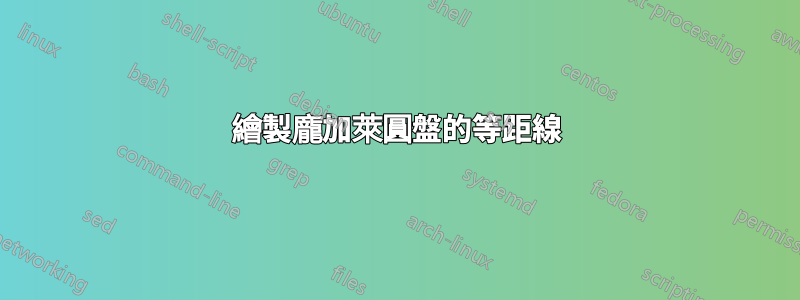
試著繪製龐加萊圓盤的「等距離」線,如這篇文章所示:https://math.stackexchange.com/a/1343730/390217
這是程式碼,您可以透過使用值和函數來獲得一些漂亮的圖片。
\documentclass[border=5pt]{standalone}
\usepackage{tkz-euclide}
\usepackage{tikz}
\usetikzlibrary{calc}
\usepackage{fp}
\usepackage{comment}
\begin{document}
\begin{tikzpicture}[scale=3]
\tkzDefPoint(0,0){O}
\tkzDefPoint(1,0){A}
\tkzDrawCircle(O,A)
\draw (A) -- (-1,0);
\draw (0,1) -- (0,-1);
\foreach \nt in {0.1,0.2,...,1}{
\pgfmathsetmacro\nx{cosh(\nt)}
\pgfmathsetmacro\ny{sinh(\nt)}
\pgfmathsetmacro\mx{(-\nx)}
\pgfmathsetmacro\my{(-\ny)}
\tkzClipCircle(O,A)
\tkzDefPoint(\nx,\ny){z1}
\tkzDefPoint(\nx,\my){z2}
\tkzDefPoint(\mx,\my){z3}
\tkzDefPoint(\mx,\ny){z4}
\tkzDefPoint(\ny,\nx){z5}
\tkzDefPoint(\my,\nx){z6}
\tkzDefPoint(\my,\mx){z7}
\tkzDefPoint(\ny,\mx){z8}
\tkzDrawCircle[orthogonal through=z1 and z2](O,A)
\tkzDrawCircle[orthogonal through=z3 and z4](O,A)
\tkzDrawCircle[orthogonal through=z1 and z4](O,A)
\tkzDrawCircle[orthogonal through=z2 and z3](O,A)
\tkzDrawCircle[orthogonal through=z5 and z6](O,A)
\tkzDrawCircle[orthogonal through=z7 and z8](O,A)
\tkzDrawCircle[orthogonal through=z5 and z8](O,A)
\tkzDrawCircle[orthogonal through=z6 and z7](O,A)
}
\end{tikzpicture}
\end{document}
有人知道我是否可以通過調整函數或值得到正確的結果嗎?我不知道如何透過投影拋物面的類時線來獲得它,就像上面提到的帖子中所解釋的那樣...
感謝您的任何幫助/建議
答案1
問題解決了 !
我聯繫了上述圖片的作者,他慷慨地向我發送了所使用的代碼。這是電腦生成的一個非常長的座標點列表,因此我使用 tikz-euclide 和對稱性對其進行了調整以盡可能減少它。結果是完美的。這是有興趣的人的代碼:
\documentclass[border=5pt]{standalone}
\usepackage{tkz-euclide}
\usepackage{tikz}
\usetikzlibrary{calc}
\usepackage{fp}
\usepackage[active,tightpage]{preview}
\PreviewEnvironment{tikzpicture}
\setlength\PreviewBorder{10pt}%
\begin{document}
\begin{tikzpicture}
\pgfsetlinewidth{0.4pt}
\useasboundingbox (0in,0in) rectangle (6in,6in);
%circle
\def\rad{3in}
\node (O) at (3in,3in) []{};
\draw (O) circle (\rad);
\node (A) at (6in,3in) []{};
\pgfsetlinewidth{0.8pt}
%arcs
\draw (3in,0)--(3in,6in); %vertical
\draw (0,3in)--(6in,3in); %horizontal
\foreach \x/\y in {
2.27947/0.210234,
1.67325/0.431525,
1.22212/0.705443,
0.906042/0.973135,
0.687819/1.20952,
0.53563/1.40973,
0.427272/1.57697,
0.34825/1.71661,
0.289239/1.83382,
0.244185/1.93299,
0.209092/2.01764,
0.181261/2.09053,
0.158834/2.15381,
0.140503/2.20918,
0.125327/2.25798}{
\tkzClipCircle(O,A)
\pgfmathsetmacro\ny{6-\y}
\node (z1) at (\x in,\y in) []{};
\node (z2) at (\x in,\ny in) []{};
\node (z3) at (\y in,\x in) []{};
\node (z4) at (\ny in,\x in) []{};
\pgfmathsetmacro\nx{6-\x}
\node (z5) at (\y in,\nx in) []{};
\node (z6) at (\ny in,\nx in) []{};
\node (z7) at (\nx in,\y in) []{};
\node (z8) at (\nx in,\ny in) []{};
\tkzDrawCircle[orthogonal through=z1 and z2](O,A)
\tkzDrawCircle[orthogonal through=z3 and z4](O,A)
\tkzDrawCircle[orthogonal through=z5 and z6](O,A)
\tkzDrawCircle[orthogonal through=z7 and z8](O,A)
}
\end{tikzpicture}
\end{document}




